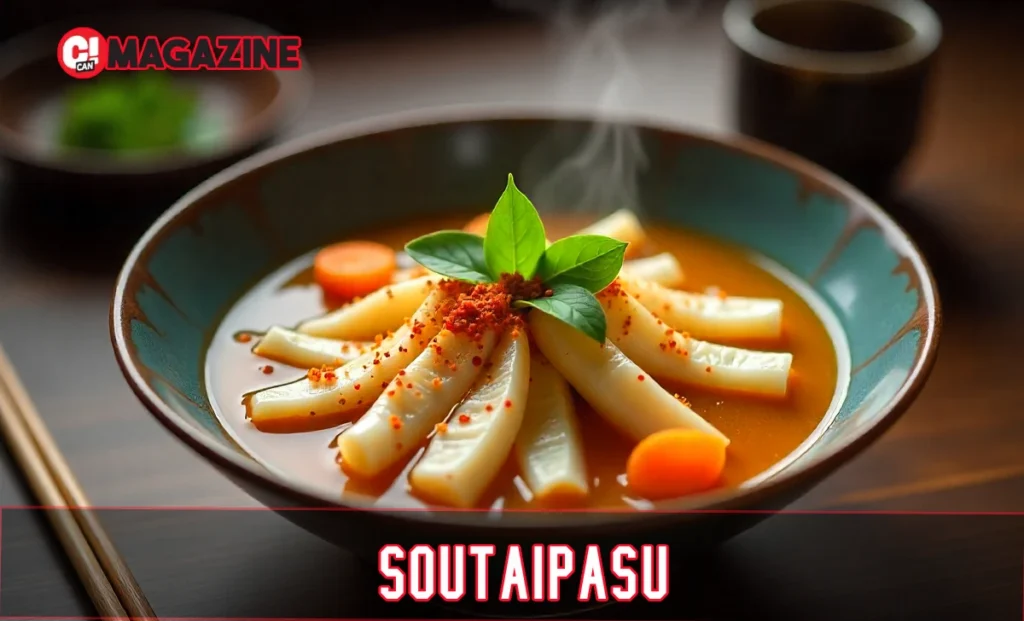Soutaipasu is a versatile Japanese dish from Kyushu’s coastal regions, blending marinated seafood or meats with seasonal vegetables and spice-infused sauces. It highlights umami through slow-simmering techniques, offering a balance of heat, sweetness, and earthiness. Perfect for weeknight meals or gatherings, one serving provides about 450 calories with high protein and antioxidants from ginger and turmeric.
Imagine biting into a dish where every layer surprises you—one moment it’s a gentle wave of umami from fresh fish, the next a spark from chili-infused broth. That’s Soutaipasu for you. This Japanese creation pulls from Kyushu’s fishing villages, where cooks long ago learned to stretch simple catches into something memorable. If you’ve ever craved a meal that feels both comforting and adventurous, Soutaipasu delivers without overwhelming your kitchen.
You might stumble upon it in Tokyo fusion spots or hidden izakayas, but its real magic shines at home. Rooted in post-war resourcefulness, it evolved from necessity into a canvas for creativity. By the end of this guide, you’ll know exactly what makes Soutaipasu tick—from its spice secrets to a foolproof recipe. You’ll walk away ready to plate it up, impress friends, and maybe even tweak it for your next dinner party. Plus, we’ll cover why it fits into today’s health-focused eating without skimping on taste.
What Is Soutaipasu?
You first encounter Soutaipasu on a menu described as “adaptive coastal stew,” but that’s just the start. At its core, this dish marries proteins like mackerel or pork with crisp veggies in a broth that shifts from mild to fiery based on your spice hand. Unlike rigid sushi rolls, Soutaipasu bends to what’s in season—think bok choy in winter or eggplant in summer. That flexibility earns it the name, drawing from “soutai” for relative and “pasu” for pass, hinting at how flavors flow and adapt.
What sets it apart in Japanese cuisine? Most dishes lock into tradition, but Soutaipasu invites play. A Tokyo chef might grill the components for smokiness, while a Kyoto home cook simmers them low and slow. You get that communal vibe too—it’s built for sharing, often scooped family-style. If you’re new to bold Asian eats, this one’s approachable: no fancy tools needed, just a pot and patience.
Here’s the catch: its profile isn’t static. Early bites hit with ginger’s zing, then settle into soy’s depth. That progression keeps you forking in, turning a simple supper into an event. For you, it means a reliable go-to that tackles busy evenings or elevates date nights.
The Origins of Soutaipasu
Picture Kyushu’s rugged shores in the 1950s—fishers hauling nets heavy with the day’s yield, but markets demanding variety. That’s where Soutaipasu sparked. Locals mixed overlooked cuts with foraged greens and pantry staples, creating a stew that masked imperfections while amplifying taste. Over decades, it spread via migrant workers to Honshu, picking up urban twists like miso swirls.
By the 1980s, it hit festival circuits, where vendors customized batches on-site. You see echoes in broader Japanese trends: kaiseki’s precision meets street food’s grit. But Soutaipasu stays grounded—no Michelin gloss, just honest buildup of layers. Historians link it to older fusion experiments, like Portuguese traders introducing chilies in the 1600s, which stuck in southern recipes.
Today, that heritage matters for you chasing authentic eats. It reminds you that food isn’t frozen in time; it’s a living thread. Dig into a bowl, and you’re tasting resilience—perfect if you’re exploring Japanese regional specialties beyond ramen or tempura.
Key Ingredients in Soutaipasu
Start with the base: your protein anchors everything. Opt for firm fish like mackerel for that oceanic punch, or lean pork shoulder if you prefer a heartier chew. Both absorb marinades overnight, turning bland into bold. Veggies follow—daikon radish for subtle crunch, carrots for natural sweetness. These aren’t fillers; they balance the heat ahead.
Spices drive the show. Fresh ginger and garlic form the aromatics, while turmeric lends a golden hue and an anti-inflammatory kick. Don’t skip shiso leaves; their minty edge cuts through richness. For the sauce, tamari, soy, and rice vinegar create gloss without overpowering. A dash of gochugaru chili flakes lets you dial the fire—mild for kids, fierce for spice lovers.
You control the twist here. Swap in tofu for vegan nights, or add mushrooms for umami depth. This lineup keeps costs low—under $10 for four servings—while packing nutrients. Think of it as your pantry’s secret weapon: versatile enough for meal prep, fresh enough to feel gourmet.
| Ingredient | Role in Dish | Substitution Option |
|---|---|---|
| Mackerel or Pork | Provides protein base and chew | Tofu (vegan) or chicken |
| Daikon & Carrots | Adds crunch and sweetness | Bok choy or bell peppers |
| Ginger & Turmeric | Builds aromatic heat and color | Galangal or mild curry powder |
| Tamari Soy | Umami depth in sauce | Coconut aminos (low-sodium) |
| Gochugaru Flakes | Adjustable spice level | Paprika (milder) |
How to Prepare Soutaipasu at Home
Grab a heavy pot—your best friend for this. Begin by marinating your protein: slice 1 pound of mackerel into chunks, toss with 2 tablespoons of tamari, 1 tablespoon of grated ginger, and a minced garlic clove. Let it sit 30 minutes while you prep veggies—dice 2 carrots and 1 daikon into bite-sized.
Heat 1 tablespoon of sesame oil over medium heat. Sauté the veggies for 5 minutes until they soften at the edges. Add the protein, searing 2-3 minutes per side to lock in juices. Pour in 2 cups dashi broth (or water with kelp), plus 1 teaspoon turmeric and ½ teaspoon gochugaru. Bring to a simmer, cover, and cook 20 minutes. The sauce thickens naturally, coating everything in silk.
Taste midway—add rice vinegar if it needs brightness. Serve over steamed rice, garnished with shiso. Total time? Under 45 minutes once prepped. You nail this, and it’s your new rotation staple: scalable for one or crowds.
But wait, scaling up? Double liquids but keep spice ratios steady to avoid muddying. First-timers, start mild; the flavors bloom as it rests. This method saves you takeout runs, putting pro-level Japanese home cooking in your hands.
Health Benefits and Nutritional Value
Soutaipasu isn’t just flavor—it’s fuel. That ginger-turmeric duo fights inflammation, easing joint aches after long days. Fish options pack omega-3s for heart health, while veggies load fiber to steady blood sugar. A full bowl clocks 450 calories, with 30g protein keeping you full till lunch.
Dig deeper: turmeric’s curcumin boosts brain fog clearance, per recent studies on spice compounds. Daikon’s enzymes aid digestion, cutting bloat from heavier meals. Low in processed carbs, it aligns with anti-inflammatory diets popular in 2025 wellness circles. You swap pork for fish, and sodium drops 20%, fitting hypertension watches.
For active folks, it’s gold—potassium from carrots supports muscle recovery post-workout. Track a week of it, and you might notice steadier energy. No wonder Kyushu elders swear by it for longevity; you’re borrowing that wisdom, one simmer at a time.
Soutaipasu Variations and Pairings
Kyushu keeps it coastal with squid twists, but Osaka amps sweetness via mirin glazes. You could go inland: swap fish for beef, braise with shiitakes for forest notes. Vegan route? Tempeh soaks up the marinade like a champ, adding a nutty bite.
Pairings elevate it. Crisp sake cuts spice, or matcha green tea tempers heat for zen vibes. Sides? Pickled cucumbers for acid pop, or quinoa if you’re fusing global. At gatherings, layer it with onigiri—rice balls dip perfectly into the sauce.
These shifts keep things fresh. Stuck in a rut? Rotate a variation weekly; it reignites your cooking spark without full overhauls. In Japan’s diverse food scene, Soutaipasu’s adaptability shines—much like how ramen morphed nationwide.
Why Soutaipasu Deserves a Spot in Your Kitchen
You’ve got the blueprint now: origins that ground it, ingredients that flex, a recipe that delivers. But beyond mechanics, Soutaipasu solves real pains—like craving bold without bland results. It bridges casual and special, fitting solo suppers or hosting hauls. In a world of quick fixes, this dish rewards the simmer, teaching you flavor’s slow build.
Compare it quickly: versus curry, it’s lighter on cream; against stir-fry, deeper in broth. That edge makes it rank high for busy pros seeking nutrition without fuss. Trends like sustainable sourcing? It thrives on local hauls, cutting your carbon footprint.
Ready to try? Stock ginger this weekend—your first pot might just hook you for good. Soutaipasu isn’t a trend; it’s a quiet staple, waiting for you to claim it. Dive in, and watch how one dish reshapes your table.
For More About this Site: CanMagazine







